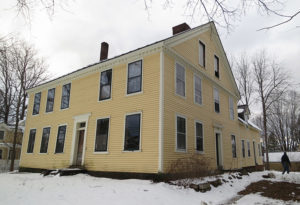Stephen Jacobs House, Windsor, VT
In this case study, students learn about the recent initiative to re-name Windsor’s Jacob Street, named after Supreme Court Judge and slaveholder Stephen Jacob, reconstruct Dinah Mason’s life through primary sources, and at the end write a persuasive essay arguing whether or not the street should be renamed.
Students first examine the 1777 Vermont constitution to understand the legal status of slavery in Vermont. They then jigsaw the documents presented here—bill of sale, Windsor census record, Windsor town meeting warrant, Windsor Poor Records, and Death Notice. Students recreate Dinah Mason’s story and decide whether Stephen Jacob or the Town of Windsor should win the case. Finally, they write a persuasive essay arguing whether or not Jacob Street should be renamed.
Grade Level: Middle/High School
Topics: Slavery; African American life in 18th- and 19th-century Vermont; Historical memory and monuments
Enduring Understanding: Slavery existed in the North and continued in Vermont after the 1777 constitution.
Compelling Question: Who decides which stories are told?
Supporting Questions: Was Vermont the first state to abolish slavery? What is the meaning of freedom?
Historical Thinking Skills: Primary Source Analysis; Synthesizing Sources; Historical Interpretation
Historical Background:
A case study of Dinah Mason adds real historical figures and complexity to the story of slavery in early Vermont. Dinah Mason was an enslaved African American woman owned by Jotham White in Charlestown, NH. In 1783 Stephen Jacob of Windsor, a lawyer who became a judge and served on the Vermont Supreme Court, purchased Dinah and brought her to his home where she served him and his family for 17 years, washing, cooking, and cleaning. As Dinah’s eyesight began to fail and she became ill (at only age 47), Jacob turned her out of his home. In 1801 the town of Windsor sued Jacob to force him to cover the town’s expenses in caring for Dinah. The Supreme Court decided in Jacob’s favor, arguing that Dinah could not have been a slave because slavery had been illegal in Vermont since 1777. For more background, watch this lecture about the persistence of slavery in Vermont and Dinah’s story or read this article DeFacto Slavery: The Case of Dinah Mason White
Hook/Introducing the Case Study:
The Jacob Street Controversy: Listen to the story. As a class, identify the two sides of the controversy. Explain to the class that they will be examining historical documents to uncover more about the story.
Activating Prior Knowledge/Building Context:
Vermont is widely advertised as being the first state to abolish slavery. Was it? Often the historical documents are more complicated. Use the linked worksheet to close-read and summarize the slavery clause of the 1777 Vermont Constitution. As a class discuss whether or not Vermont abolished slavery in 1777.
Investigation of Primary Sources:
Jigsaw Activity. Assign one document to small groups or pairs. Students source, close-read, and summarize their group document. Gather the group together and have them report out by date. Create a timeline on the board and include the 1777 Vermont Constitution as the first entry.
Note. Dinah would have been born about 1753 (students could get that from the Bill of Sale) and was enslaved in Charlestown, NH.
Document 1: 1783 Bill of Sale—Worksheet asks them to connect this to the VT Constitution
Document 2: 1790 census—There are 2 “all other free” people in the household, one probably Dinah. Document 1 says she’s enslaved; Document 2 says she isn’t.
Document 3: 1800 Town Meeting Notice—Worksheet asks them what this document proves.
Document 4: 1809 Windsor Poor Records—This document shows Dinah’s decline from Leonard Freeman “keeping” Dinah, to the doctor “attending” her, to her eventual burial.
Document 5: 1809 Death Notice: Dinah has no last name in this notice.
Class Discussion:
Discussion. Vermont law stated that towns were responsible for caring for the sick and poor who did not have family support. As Dinah became ill, she was forced from Stephen Jacob’s household. The town went to court to try to have Jacob pay to support Dinah, arguing that she was enslaved to Jacob and thus his responsibility. Was she enslaved or not? How do you think the Court decided the case?
- Have one group of students summarize the town’s arguments. What document might they have used to argue their case? (the bill of sale)
- Have a second group of students summarize Jacob’s arguments. What document might they have used to argue their case? (the VT Constitution; Census)
The court decided in favor of Jacob, arguing that the bill of sale could not be used as evidence because slavery was illegal in Vermont. Here’s a good summary of the case.
Do students notice that Dinah did not have an opportunity to speak on her own behalf? Why might that have been? What might she have said if her voice had not been marginalized?
Summative Assessment:
Write a persuasive argument for why or why not Jacob Street should be renamed.
Here’s what the Selectboard of Windsor decided.
Extended Discussion Points to Consider:
Note that the court case wasn’t about whether slavery was wrong.
The case reveals that this slaveowner did not feel as if he owed his former slave, Dinah, anything even though she had worked for him so long.
The case reveals how tenuous freedom was and asks us to think about what happened to enslaved people after they became free.
Background Historical essay: The Problem of Slavery in Early Vermont
Background article about the controversy: The Jacob Street Controversy
Primary Sources:
